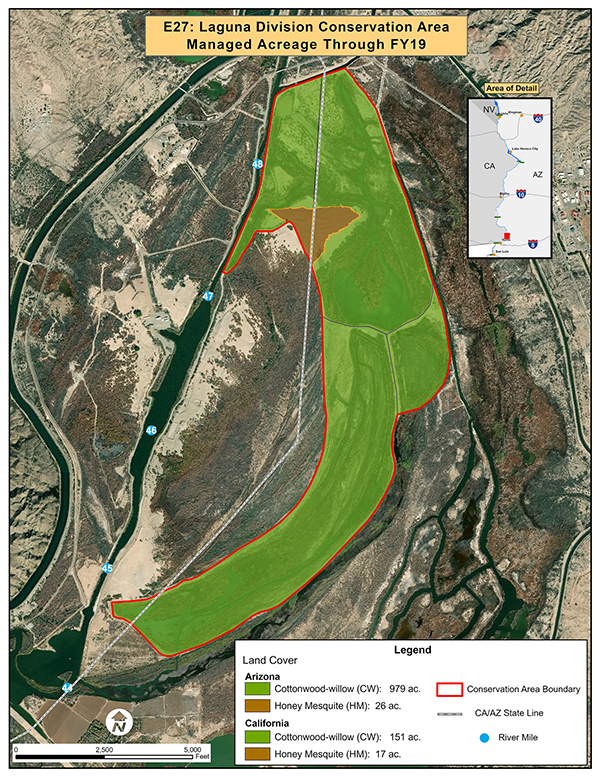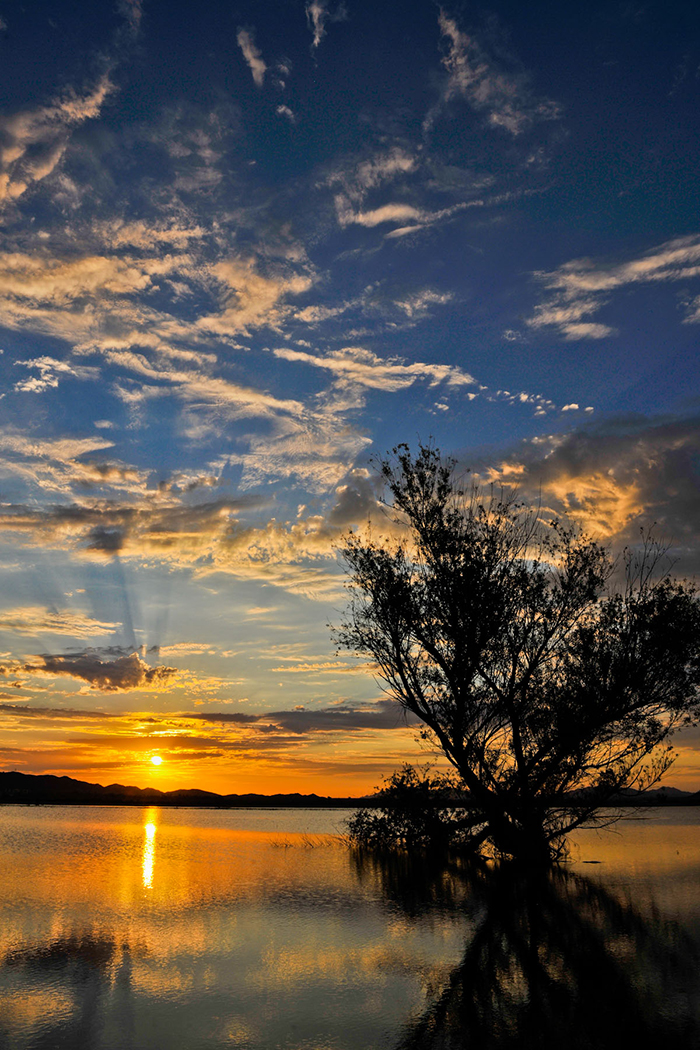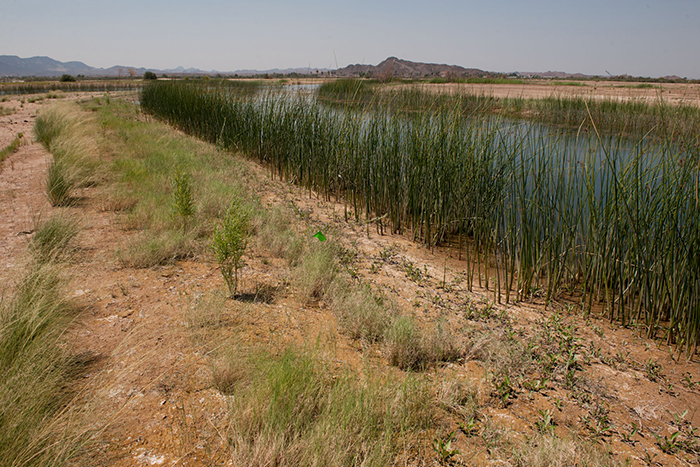



- DESCRIPTION
- LOCATION
- SPECIES USE
- ACTIVITIES
- MULTIMEDIA
The Laguna Division Conservation Area (LDCA) is a large-scale restoration project to create a mosaic of native land cover types. The goal of this project is to restore, enhance, and protect native habitat for the benefit of Lower Colorado River Multi-Species Conservation Program (LCRMSCP) covered species and other plants and wildlife. Approximately 1,200 acres of native vegetation has been restored creating riparian and marsh habitat.
In 2007, the Laguna Division Planning Group was formed. Their intent was to identify potential restoration projects within this reach of the river, and combine resources in the area to ensure any actions taken minimally impacted other potential restoration projects or ongoing river operations.
The Laguna Division Planning Group consists of representatives from the following organizations:
- Arizona Department of Water Resources
- Arizona Game and Fish Department
- California Department of Fish and Game
- Pacific Institute
- U.S. Fish and Wildlife Service
- Bureau of Land Management
- Bureau of Reclamation
The product from the planning group was identified as the Laguna Division Conservation Area (LDCA). Construction and restoration of the area began November 2011 and was completed spring 2015. The LDCA replaced large saltcedar stands with a mosaic of open water, marsh, riparian, and upland habitat. These land cover types are maintained with a maximum base flow of 100 cfs from the Gila Gravity Main Canal settling basin. To minimize earthwork during construction of the site, cuts and fills followed the pre-existing topography where feasible. Adjacent terraces were graded to allow flooding and promote the establishment of native riparian species. Water control structures are used to manage water levels within the conservation area where native vegetation receive water by raising and lowering the water surface. Additional project timeline information can be found in the “Activities” tab.
The habitat of the LDCA is expected to attract a variety of LCR MSCP covered species including the California black rail, Yuma clapper rail, western least bittern, southwestern willow flycatcher, yellow-billed cuckoo, and the Yuma hispid cotton rat. Several bird species recently detected during 2016 surveys include: Sonoran yellow warblers, Arizona Bell’s vireos, and Yellow-billed cuckoo.
A fact sheet for this Conservation Area can be found here. Technical Reports for this Conservation Area can be found here.
Updated January 7, 2020
The Laguna Division Conservation Areais within the historic floodplain of the LCR, adjacent to River Miles 43-49. Located on Reclamation withdrawn lands in both Arizona and California, the conservation area is approximately 23 miles north of Yuma, Arizona. The site is nestled between Imperial Dam and Laguna Dam, with the Mittry Lake Wildlife Area to the east and the Laguna settling basin to the west.
For specific information on the Conservation Area, please contact Terry Murphy, Restoration Group Manager, at (702) 293-8140 or via email at tmurphy@usbr.gov.
The image below shows a close up of the conservation area.
Each Conservation Area targets certain LCR MSCP covered and evaluation species habitats. Below, on the left, is a list of the LCR MSCP species in which habitat will be targeted for creation for this particular conservation area. To the right is a list of LCR MSCP species that, through monitoring, have been found utilizing the conservation area.
| Targeted LCR MSCP Species | LCR MSCP Species Utilizing Site |
| Riparian Obligates | Riparian Obligates |
| Arizona Bell's Vireo | Arizona Bell's Vireo (breeding) |
| Elf Owl | |
| Gila Woodpecker | Gila Woodpecker (breeding) |
| Gilded Flicker | |
| Sonoran Yellow Warbler | Sonoran Yellow Warbler (breeding) |
| Southwestern Willow Flycatcher | |
| Summer Tanager | |
| Vermilion Flycatcher | Vermilion Flycatcher (transient) |
| Yellow-Billed Cuckoo | Yellow-Billed Cuckoo (possible breeding) |
| Bats, Small Mammals, and Insects | Bats, Small Mammals, and Insects |
| Yuma Hispid Cotton Rat | Yuma Hispid Cotton Rat |
| Marsh Birds | Marsh Birds |
| Western Least Bittern | |
| Yuma Clapper Rail |
Water managment, including maintaining the water control structures, is the primary management activity at LDCA. Non-native vegetation control occurred on the site following planting activities where recently disturbed. Wet soils offered ideal recruitment areas for non-native plants.
Bird Monitoring
Surveys for covered birds are conducted annually. Marsh bird surveys are conducted in March, April, and May at established points for California black rail, western least bittern, and Yuma clapper rail. During the late spring and summer, presence surveys are conducted for riparian birds to document use of the conservation area for nesting, foraging, and migration. Riparian birds monitored include the listed southwestern willow flycatcher and yellow-billed cuckoo, and the following covered species: Arizona Bell’s vireo, Gila woodpecker, gilded flicker, yellow warbler, summer tanager and vermilion flycatcher.
Mammal Monitoring
Small mammal live trapping is conducted annually to monitor presence of Colorado River cotton rats and desert pocket mice.
Acreage Map
This map shows the acreage for this area. You can click on the map for a larger view.
This gallery includes photos of this conservation area. If you require larger photos, please contact our webmaster Michelle Reilly at mreilly@usbr.gov.
Below is a video on the Laguna Diversion Conservation Area project.













